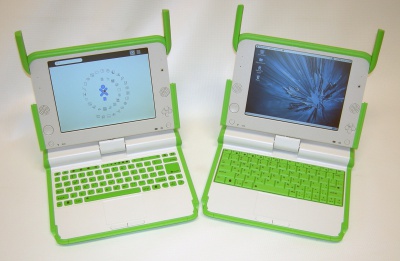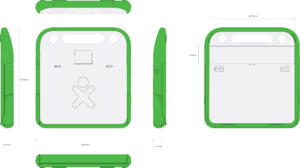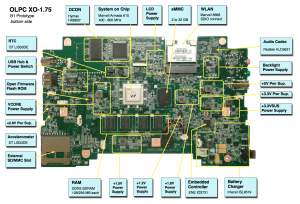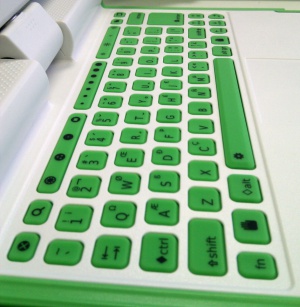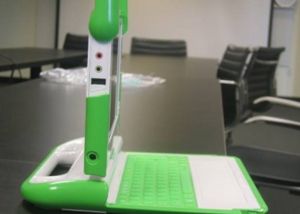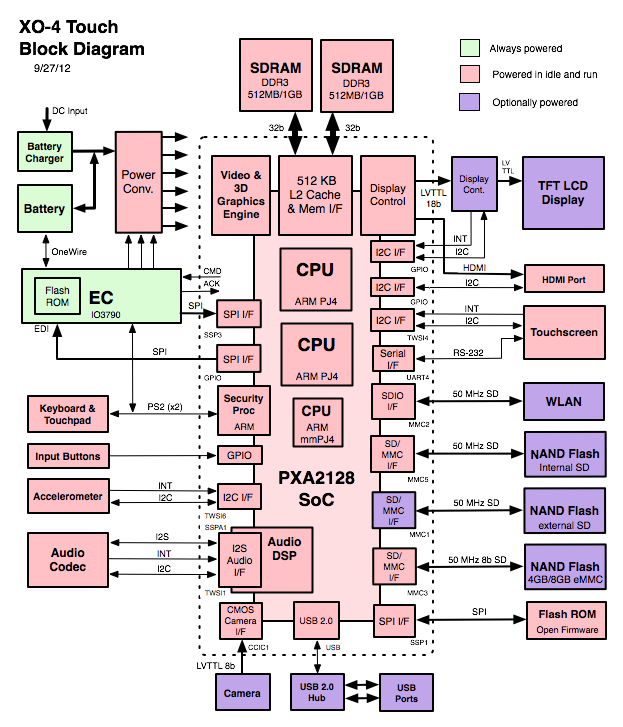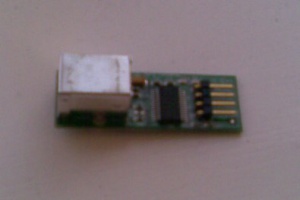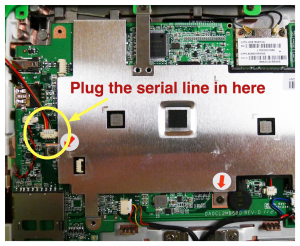XO-4 Touch
The XO-4 Touch laptop is the latest refresh of the XO laptop. It is available in two models: XO-4 and XO-4 Touch, with the latter providing multi-touch input on the display. Like the XO-1.75, it uses an ARM processor to provide high performance with low power consumption, while keeping the industrial design and batteries of the XO-1.
XO-4 laptops ship with OLPC OS 13.2.7 based on Fedora 18, including both Sugar and GNOME software. An Android build can be used by deployments but is not offered from factory.
Identification
The XO-4 laptops are identified by set of four dots in a diamond on both sides of the hinge cover. XO-4 Touch units have a slightly deeper (1mm) bezel around the display.
Specifications
The definitive XO-4 laptop specification is only available in PDF form ("CL4" is the model identifier in the manufacturing data for the XO-4 and XO-4 Touch hardware).
- The specs below are not authoritative, please refer to the PDF version of the spec linked above.
Physical dimensions
- Approximate dimensions: 245mm × 230mm × 30.5mm (see drawing to the right for detailed dimensions)
- Approximate weight
- with LiFePO4 battery: 1.36KG (~3lbs);
- with NiMH battery: 1.58KG (~3.48lbs);
- with LiPoly battery: (not yet determined);
- Configuration: Convertible laptop with pivoting, reversible muti-touch enabled display; dirt- and moisture-resistant system enclosure; no fan.
Core electronics
XO-4 is designed around the Marvell PXA2128 system on a chip.
- CPU: dual Marvell PJ4 ARM cores;
- CPU clock speed: 1 GHz (superscalar and out-of-order instruction execution);
- ARM instruction set compatible (including Thumb-2 and Wireless MMX2);
- ARMv7 architecture compatible;
- 32 KB L1 I-cache and 32 KB L1 D-cache per processor, shared 512KB L2 cache;
- The PXA2128 includes hardware video encode/decode, a GC2000 3D graphics engine, display controller, USB, SDIO, and other system interface and management functions
- Embedded Controller: ENE IO3790
- DRAM memory: 1 GB or 2 GB DDR3 dynamic RAM;
- Mass storage: 4 GB, 8 GB or 16 GB NAND flash in an eMMC device soldered to the motherboard.
- an internal microSD card slot for repair/replacement -- requires installing the microSD slot;
- externally accessible full-size SD card slot;
- No rotating media.
Display
- Main article: Display
- Liquid-crystal display: 7.5” dual-mode TFT display;
- Viewing area: 152.4 mm × 114.3 mm;
- Two "modes" depending on lighting conditions:
- (1) Grayscale (B&W) reflective mode: for outdoor use—sunlight-readable; primarily lit from the front by ambient light; high-resolution (200 DPI), 1200(H) × 900(V) grayscale pixels; power consumption 0.1–0.2Watts;
- (2) Color, backlight mode: for indoor use; primarily lit from behind by the LED backlight; built in sub-pixel sampling of the displayed color information results in a perceived resolution of approximately 984(H) × 738(V); power consumption 0.2–1.0Watts;
- The display-controller chip (DCON) formats data for the display. (DCON Datasheet)
- Note: web browser images are currently scaled up so that an image of very roughly [800 × 600] fills up the browser window.
Touchscreen
The XO-4 Touch has the ability to sense and track two simultaneous touches of the display. In order to provide this functionality without degrading the performance of the display in direct sunlight, an infrared touchscreen technology from Neonode is used. This technology is also capable of sensing and tracking any stylus with a diameter larger than 8mm. To avoid damaging the surface of the display, it is recommended that any stylus have a relatively soft tip. See also touchscreen troubleshooting.
eBook Reader
The screen can pivot and folded backwards so the XO-4 Touch becomes a tablet or eBook reader. Several buttons on the frame offer different modes of paging, scrolling, etc.
Integrated peripherals
- Keyboard: 80+ keys, 1.0mm stroke; sealed rubber-membrane key-switch assembly;
- Keyboard Layouts
- Layout pictures: English, Arabic, Thai, West African (Nigeria), Portuguese, Spanish, Amharic, French, Urdu, Cyrillic, Turkish (not final), Nepali, Mongolian, Kazakh, Devanagari, Uzbek, Pashto, Dari, Pulaar (Fula), Italian
- A non-membrane "traditional" keyboard is also available.
- Gamepad: Two sets of four-direction cursor-control keys;
- Touchpad: Capacitance touchpad
- Audio: Internal stereo speakers and amplifier; internal monophonic microphone; jacks for stereo external headphones and microphones.
- Realtek ALC5631 audio codec (I2S)
- Camera: integrated color video camera; 640 x 480 resolution at 30 FPS;
- Independent (and undefeatable by software) display of microphone and camera recording status;
- The camera and device driver support disabling AGC and automatic color balancing, to enable its use as a photometric sensor for educational applications;
- Omnivision OV7670, or compatible,
- Wireless Networking: Integrated 802.11b/g (2.4GHz) interface; dual adjustable, rotating antennas;
- Marvell 88w8686 WLAN module, with SDIO interface, on removable module, 2.4 GHz only;
- Marvell 88w8787 WLAN module, with SDIO interface, on removable module, 2.4 GHz, 5 GHz, and Bluetooth;
- Remains powered while the laptop suspends, waking the laptop if a packet addressed to it arrives.
- Ad-hoc networking available
- Accelerometer: ST LIS3DH three axis accelerometer (data sheet (PDF))
- Status indicators:
- Power, battery, Wi-Fi, one software controlled (intended for onboard flash access), visible with lid open or closed;
- Microphone In-Use, and Camera In-Use, visible when lid is open.
- Light Sensor: a reverse biased LED.
External connectors
- DC power: 6mm (1.65mm center pin) connector; 11 to 24 V input usable, –32 to +40V input tolerated; power draw limited to 25 W; - see power connector dimensions at Battery and power.
- Maximum Power Point Tracking alters voltage/current for maximum battery-charging power from solar panels
- Headphone output: standard 3.5mm 3-pin switched stereo audio jack;
- Microphone input: standard 3.5mm 3-pin switched stereo microphone jack; selectable 2V DC bias; selectable sensor-input mode (DC or AC coupled);
- USB: Two Type-A USB 2.0 connectors; Up to 1A power supplied (total, available through a single connector);
- HDMI: A micro-HDMI connector is provided, supporting video output
- Flash Expansion: full-size SD Card slot.
Battery
- Pack type: 2 or 4 cells LiFePO4; 5 cells NiMH, or 4 cells LiPoly, approx. 6V series configuration;
- Capacity: 2800 mAh (LiFePO4), 3000 mAh (NiMH), or 2800 mAh (LiPoly),
- Weight: 188 g (LiFePO4), 292 g (NiMH), or 147.5 g (LiPoly),
- Fully-enclosed “hard” case; user removable;
- Electronics integrated with the pack provide:
- Identification;
- Battery charge and capacity monitoring chip (Maxim DS2756 data sheet, or to-be-determined);
- Thermal, over-voltage, and over-current sensors along with cutoff switches to protect battery;
- An emergency over-voltage sensor which melts a series fuse, permanently disabling the battery (LiPoly only),
- Minimum 2,000 charge/discharge cycles (to 50% capacity of new).
See Laptop Batteries or more information.
BIOS/loader
On XO-4, there are two different firmwares installed:
- A small bootloader written in Forth and interpreted by CForth runs on the security processor (a small ARM core in the PXA2128)
- Open Firmware runs on the main (PJ4) processor
The bootloader run by the CForth interpreter on the security processor is responsible for initializing the SoC pins and the main memory. It then loads Open Firmware into main memory and starts it executing on the main processor. This CForth bootloader then continues to execute on the security processor, processing input from the keyboard and touchpad.
Open Firmware (OFW) initializes the system peripherals, then loads the OS kernel into memory and starts executing it. OFW also includes hardware diagnostics.
- A dedicated 2 MiB SPI-interface flash ROM contains both CForth (first 128KB) and OFW;
- Hardware support is provided to prevent reprogramming of the OFW flash ROM by malicious software;
Environmental specifications
- Temperature: 0 to 50 degrees Celsius (operating); -20 to 60 degrees Celsius (non-operating)
- Humidity: UL certification planned to IP42 when closed, the unit should seal well enough that children walking to and from school need not fear rainstorms and dust;
- Maximum altitude: –15m to 3048m (14.7 to 10.1 PSIA) (operating), –15m to 12192m (14.7 to 4.4 PSIA) (non-operating);
- Shock 125g, 2ms, half-sine (operating) 200g, 2ms, half-sine (non-operating);
- Random vibration: 0.75g zero-to-peak, 10Hz to 500Hz, 0.25 oct/min sweep rate (operating); 1.5g zero-to-peak, 10Hz to 500Hz, 0.5 oct/min sweep rate (nonoperating);
- 2-3mm plastic walls (1.3mm is typical for most systems).
Regulatory requirements
- The usual US and EU EMI/EMC (electromagnetic-interference and electromagnetic-compatibility) requirements;
- The laptop meets IEC 60950-1, EN 60950-1, and CSA/UL 60950-1 (safety) specifications. It also complies with UL 1310 and UL 498. In order to guarantee the safety of children using the laptop, it passes ASTM F 963 (Standard Consumer Safety Specification on Toy Safety, 2003 edition);
- The external power adapter complies with IEC, EN, and CSA/UL 60950-1;
- The removable battery pack complies with IEC, EN, and CSA/UL 60950-1 and UL 2054;
- RoHS (Restriction of Hazardous Substances Directive – EU) and CPSIA (USA) compliant.
- Full list of certifications
Block Diagram
Software upgrade considerations
There are four distinct pieces of software on the XO-4:
- Operating System and user interface, now part of OLPC's formal development process (see 13.1.0 for the initial offering)
- Open Firmware (OFW), (see #Upgrading_OFW below),
- Embedded controller (EC) firmware, (see #Upgrading_OFW below).
- Touchscreen firmware (only on XO-4 Touch units)
All the firmware images are included in the operating system builds, so usually just installing a new OS and rebooting (with a charged battery, and external power connected) is enough to upgrade everything.
There are some exceptions that apply to pre-production units (in the hands of developers and testers):
A units
A-test units (very early prototypes) are no longer supported - don't bother trying to upgrade them.
Upgrading from Open Firmware Q7B01
If you are running firmware Q7B01, the system will not boot (you just get the 'ok' prompt), and automatic firmware upgrade will not happen. You must upgrade manually to e.g. q7b02, using the instructions below.
Touchscreen no longer responsive
XO-4 firmware Q7B11 breaks automatic upgrade for touchscreen firmware versions before 0.0.0.10 on C1 models. After reflashing to Q7B11 (or later) from an earlier version, you must (just this once) manually upgrade with
ok update-nn-flash
Otherwise the touchscreen will not work. More info can be found at XO_4_Touch_Testing#Reprogramming_the_Neonode_Firmware.
This does not apply to B1 units, where the touchscreen will continue to work over this upgrade, intentionally locked to an old touchscreen firmware version.
Refusal to update EC code
When upgrading from old software versions, Open Firmware may refuse to update the EC firmware, showing a battery icon with a bad face on every boot, and logging the following messages over serial and during verbose boot:
EC command result timeout Skipping EC reflash, not enough power
This is due to a change in how OFW gets battery status. To solve this, with a charged battery and external power connected, run at the ok prompt:
update-ec-flash
Manually Upgrading OFW
Place a recent release of the Q7BYY firmware onto an SD device, and place it in the external SD slot, or on a USB drive.
Interrupt the Open Firmware (OFW) boot process by pressing the ESC key.
Type:
flash ext:\q7BYY.rom
Or for a USB drive:
flash u:\q7BYY.rom
The laptop will automatically reboot.
If you need to do this to a bare motherboard, you can use the flash! command which skips the tests for two sources of power.
If the version of OFW installed on the laptop isn't working, you might be able to upgrade it using CForth or using JTAG.
Manually upgrading EC
Download the latest EC code from: http://dev.laptop.org/pub/ec/. It should be prefixed by "cl4" (e.g. cl4-7.0.4.11.img). Place this file on a USB drive or SD card, and insert it into the laptop being reprogrammed.
From Open Firmware, type:
flash-ec u:\your_filename.img
If you need to do this to a bare motherboard, you can use the flash-ec! command which skips the tests for two sources of power.
Manually upgrading touchscreen firmware
See XO_4_Touch_Testing#Reprogramming_the_Neonode_Firmware.
Software Restrictions
See Trac.
More Information
- XO-4 C2 production model
- XO-4 A1, A2, B1, and C1 pre-production prototype
- Motherboard photos
- XO-4 Touch Testing
- Firmware
- Open Firmware ARM Startup
- Analysis and recovery of SPI FLASH on XO-4 using an XO-1.5 as host
- Safety and RF Certifications
Serial Adapter
For firmware, operating system and kernel debugging a serial adapter is required. We are using our third generation serial adapter with the XO-4, which has 3.3V serial on the target side, and a USB B socket on the host side.
Location of serial port (it is in the same location as on an XO-1.75).
To use the serial port, disassemble the laptop (instructions) and connect the serial adapter to the motherboard at the point shown. The heat spreader does not have to be removed.
